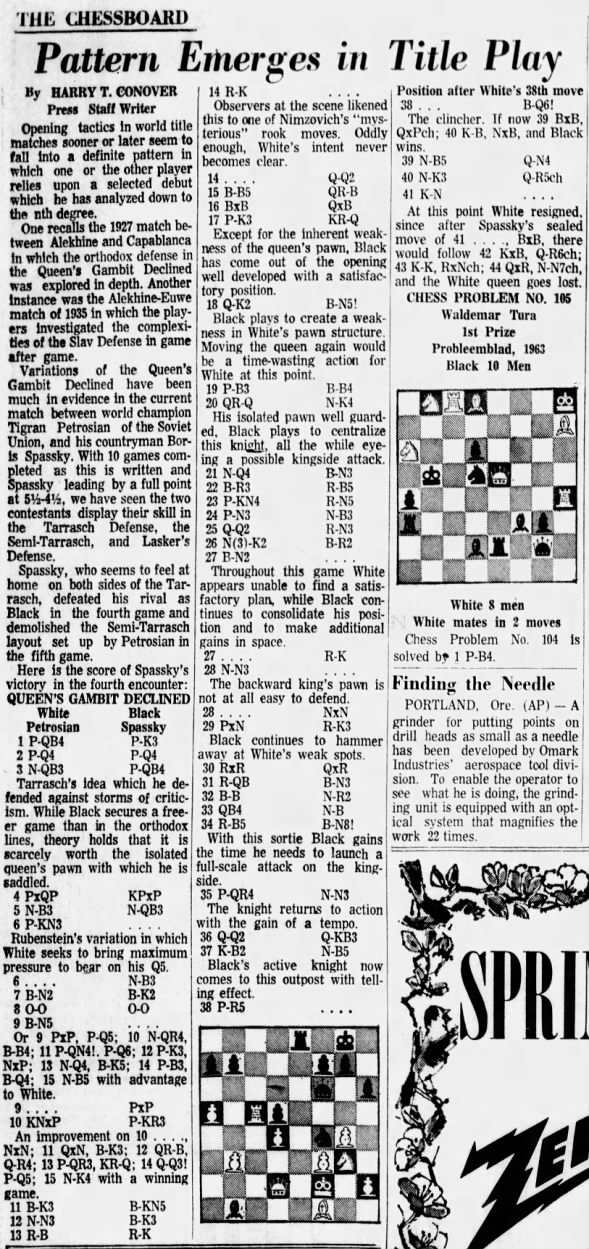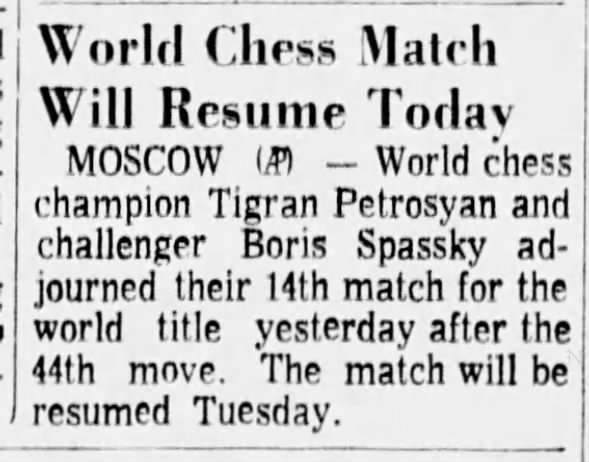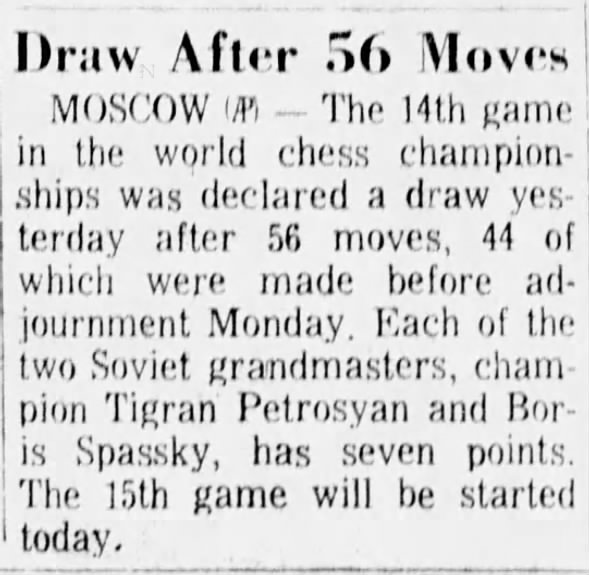 The Chessboard 18 May 1969, Sun Asbury Park Press (Asbury Park, New Jersey) Newspapers.com
The Chessboard 18 May 1969, Sun Asbury Park Press (Asbury Park, New Jersey) Newspapers.com
The Chessboard: Pattern Emerges in Title Play by Harry T. Conover
Opening tactics in world title matches sooner or later seem to fall into a definite pattern in which one or the other player relies upon a selected debut which he has analyzed down to the nth degree.
One recalls the 1927 match between Alekhine and Capablanca in which the orthodox defense in the Queen's Gambit Declined was explored in depth. Another instance was the Alekhine-Euwe match of 1935 in which the players investigated the complexities of the Slav Defense in game after game.
Variations of the Queen's Gambit Declined have been much in evidence in the current match between world champion Tigran Petrosian of the Soviet Union, and his countryman Boris Spassky. With 10 games completed as this is written and Spassky leading by a full point at 5½-4½, we have seen the two contestants display their skill in the Tarrasch defense, the Semi-Tarrasch, and Lasker's Defense.
Spassky, who seems to feel at home on both sides of the Tarrasch, defeated his rival as Black in the fourth game and demolished the Semi-Tarrasch layout set up by Petrosian in the fifth game.
Here is the score of Spassky's victory in the fourth encounter:
Tigran V Petrosian vs Boris Spassky
Petrosian - Spassky World Championship Match (1969), Moscow URS, rd 4, Apr-21
Tarrasch Defense: Classical. Carlsbad Variation (D34)
1. c4 e6 2. d4 d5 3. Nc3 c5
Tarrasch's idea which he defended against storms of criticism. While Black secures a freer game than in the orthodox lines, theory holds that it is scarcely worth the isolated queen's pawn with which he is saddled.
4. cxd5 exd5 5. Nf3 Nc6 6. g3
Rubinstein's variation in which White seeks to bring maximum pressure to bear on his Q5.
6. … Nf6 7. Bg2 Be7 8. O-O O-O 9. Bg5
Or 9. PxP P-Q5; 10. N-QR4 B-B4; 11. P-QN4! P-Q6; 12. P-K3 NxP; 13. N-Q4 B-K5; 14. P-B3 B-Q4; 15. N-B5 with advantage to White.
9. … cxd4 10. Nxd4 h6
An improvement on 10. … NxN; 11. QxN B-K3; 12. QR-B Q-R4; 13. P-QR3 KR-Q; 14. Q-Q3! P-Q5; 15. N-K4 with a winning game.
11. Be3 Bg4 12. Nb3 Be6 13. Rc1 Re8 14. Re1
Observers at the scene likened this to one of Nimzovich's “mysterious” rook moves. Oddly enough, White's intent never becomes clear.
14. … Qd7 15. Bc5 Rac8 16. Bxe7 Qxe7 17. e3 Red8
Except for the inherent weakness of the queen's pawn, Black has come out of the opening well developed with a satisfactory position.
18. Qe2 Bg4!
Black plays to create a weakness in White's pawn structure. Moving the queen again would be a time-wasting action for White at this point.
19. f3 Bf5 20. Rcd1 Ne5
His isolated pawn well guarded, Black plays to centralize this knight, all the while eyeing a possible knight attack.
21. Nd4 Bg6 22. Bh3 Rc4 23. g4 Rb4 24. b3 Nc6 25. Qd2 Rb6 26. Nce2 Bh7 27. Bg2
Throughout this game White appears unable to find a satisfactory plan, while Black continues to consolidate his position and to make additional gains in space.
27. … Re8 28. Ng3
The backward king's pawn is not at all easy to defend.
28. … Nxd4 29. exd4 Re6
Black continues to hammer away at White's weak spots.
30. Rxe6 Qxe6 31. Rc1 Bg6 32. Bf1 Nh7 33. Qf4 Nf8 34. Rc5 Bb1!
With this sortie Black gains the time he needs to launch a full-scale attack on the kingside.
35. a4 Ng6
The knight returns to action with the gain of a tempo.
36. Qd2 Qf6 37. Kf2 Nf4
Black's active knight now comes to this outpost with telling effect.
38. a5
38. … Bd3!
The clincher. If now 39. BxB QxPch; 40. K-B NxB, and Black wins.
39. Nf5 Qg5 40. Ne3 Qh4+ 41. Kg1
At this point White resigned, since after Spassky sealed move of 41. … BxB, there would follow 42. KxB Q-R6ch; 43. K-K RxNch; 44. QxR N-N7ch, and the White queen goes lost.
41. … Bxf1
Asbury Park Press The Chessboard Sunday, May 18, 1969 Asbury Park, New Jersey Chess Problem No. 105 by Waldemar Tura,...
Posted by Bobby Fischer's True History on Sunday, November 21, 2021
Chess Problem No. 105 by Waldemar Tura, 1st Prize Probleembad, 1963. White mates in 2 moves.
FEN 1NRB3K/7B/N2p4/1k1nQ3/p6R/r4bp1/3br1q1/8 w - - 0 1
Key: R-B3/Rc3
 World Chess Match Will Resume Today 20 May 1969, Tue Asbury Park Press (Asbury Park, New Jersey) Newspapers.com
World Chess Match Will Resume Today 20 May 1969, Tue Asbury Park Press (Asbury Park, New Jersey) Newspapers.com
 Draw After 56 Moves 21 May 1969, Wed Asbury Park Press (Asbury Park, New Jersey) Newspapers.com
Draw After 56 Moves 21 May 1969, Wed Asbury Park Press (Asbury Park, New Jersey) Newspapers.com























